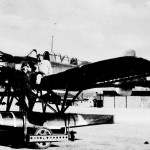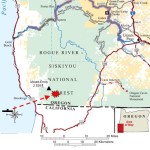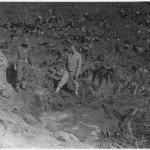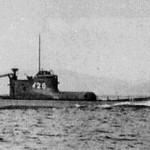SciTech Tuesday: The 75th Anniversary of the Fort Stevens Bombardment
Sometimes when I read stories from the homefront during the war I try to imagine what it must have been like. The months right after the attack on Pearl Harbor are compelling. I wrote earlier about the Battle of Los Angeles.
On June 21, 1942 Civil-War era Fort Stevens, near the mouth of the Columbia River in Oregon, was shelled by Japanese forces. The Japanese submarine I-25, with a crew of 97, and armed with a 14 cm deck gun and carrying a seaplane, opened fire. Fort Stevens commander ordered an immediate blackout, and held all fire. This prevented the submarine from accurately targeting the base. Of the seventeen shots, the only damage was to some telephone poles near the base–the remainder landed on a baseball field or a nearby wetland. Just past the battery of Fort Stevens was the northern Kaiser shipyard, which was at that time turning out a Liberty Ship each week.
Nearby training planes called in an A-29 bomber, but the submarine submerged untouched, having dodged the bombs.
This attack on continental US military base–the only one by Axis forces in WWII–led to fear of a West Coast invasion. With contemporary sinkings of passenger and freight ships off the Atlantic and Gulf Coasts, it caused fear to mount, and support for the war effort to grow.
The Japanese submarine I-25 was one of the I-15 class submarines produced for the war. It weighed in at 2,600 tons, was 350 ft long, and carried a reconnaissance plane. The plane was carried in a hangar below the deck disassembled. Quickly assembled it could carry 2 men and land on the sea. Subs of the I-15 class could travel 27 mph on the surface, and 9 mph submerged, with total range of 16,000 miles before it needed refueling. The I-25 was just off the shore of Oahu during the Pearl Harbor attack, after which it patrolled the waters off the US coast near the mouth of the Columbia River.
The night before the attack on Fort Stevens, the I-25 torpedoed and damaged a Canadian freighter loaded with cargo for England off the coast of Washington. To get up the river past minefields the next day, the crew followed fishing vessels.
On a later mission, I-25 launched its seaplane from off the coast of California, near the Oregon border. The plane flew inland into southern Oregon, and dropped incendiary bombs over forests in an attempt to cause wildfires. Recent rain and quick work by forest service personnel contained the fire quickly. In the process of putting out the fire, they recovered bomb fragments that identified the source of the fire.
I-25 was sunk off the coast of New Hebrides by the USS Ellet on September 3, 1943.
- This is a picture of the I-25's seaplane with the pilot.
- This is a map of where the I-25's plane dropped incendiary bombs later.
- This is a photo of personnel from Fort Stevens examining craters from the shells fired on it.
- This is a photo of the I-26, which was very similar to the 1-25.
All images are from Wikimedia Commons.
Posted by Rob Wallace, STEM Education Coordinator at The National WWII Museum







